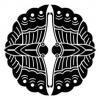Jake, firstly, Akita and Shonai are two separate regions. The founder of the Akita-Shoami school (Denbei) was born in Shonai, and his older brother (Kiyonari) who he learned a lot from, was a master of the Shonai-Shoami school. My point was that Denbei, who was originally from Shonai (but later moved to Akita) trained in the style of Shonai-Shoami. So even though he later developed his own style, we also see works in the Shonai style by him, and the picture I posted is one such example.
I know it has become fashionable to question NBTHK attributions as they are often generic and occasionally make mistakes, but the people who do these have seriously studied swords and fittings for a significant proportion of their lives. Perhaps you want it to be a Higo tsuba because such an attribution seems more appealing than Shonai, but it seems as though you are overly fixating on the 'Hosokawa' kamon. There are also four other kamon on that tsuba which you are not taking into consideration. Do these have any connection to Hosokawa?
Moreover, the fukurin on the Hirata Hikozo is completely different to your tsuba and the Denbei example (as is the shape), and is not comparable at all. Odawara fukurin are a kantei point for Hirata Hikozo. Of the two tsuba Dale listed, only one has papers (to Nishigaki). The one on Grey's website, doesn't have a fukurin and has a very different aesthetic (it's much chunkier).
I think Curran's insights (a, b, and c) explain the difference in attributions between the papered Nishigaki and yours very well. Also, look at the tagane around the nakago-ana on your tsuba, the * shaped tagane was not used by any Higo master (that I am aware of). Also, Curran knows the Higo schools very well, so if he disagrees that it is Higo, I think that it's right to accept the NBTHK's attribution of 'Shonai'.


